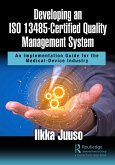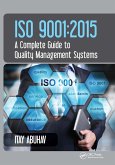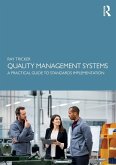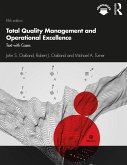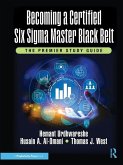David Hoyle
ISO 9000 Quality Systems Handbook-updated for the ISO 9001
2015 standard: Increasing the Quality of an Organization's Outputs
David Hoyle
ISO 9000 Quality Systems Handbook-updated for the ISO 9001
2015 standard: Increasing the Quality of an Organization's Outputs
- Broschiertes Buch
- Merkliste
- Auf die Merkliste
- Bewerten Bewerten
- Teilen
- Produkt teilen
- Produkterinnerung
- Produkterinnerung
Packed with insights into how the standard has been used, misused and misunderstood, ISO 9000 Quality Systems Handbook will help you to decide if ISO 9001 certification is right for your company and gently guide you through the terminology, requirements and implementation of practices to enhance performance.
Andere Kunden interessierten sich auch für
![ISO 9001 ISO 9001]() Ray Tricker (UK Herne European Consultancy Ltd)ISO 900181,99 €
Ray Tricker (UK Herne European Consultancy Ltd)ISO 900181,99 €![Developing an ISO 13485-Certified Quality Management System Developing an ISO 13485-Certified Quality Management System]() Ilkka JuusoDeveloping an ISO 13485-Certified Quality Management System198,99 €
Ilkka JuusoDeveloping an ISO 13485-Certified Quality Management System198,99 €![ISO 9001 ISO 9001]() Ray TrickerISO 900168,99 €
Ray TrickerISO 900168,99 €![ISO 9001 ISO 9001]() Itay AbuhavISO 900150,99 €
Itay AbuhavISO 900150,99 €![Quality Management Systems Quality Management Systems]() Ray Tricker (UK Herne European Consultancy Ltd)Quality Management Systems65,99 €
Ray Tricker (UK Herne European Consultancy Ltd)Quality Management Systems65,99 €![Total Quality Management and Operational Excellence Total Quality Management and Operational Excellence]() John S. OaklandTotal Quality Management and Operational Excellence97,99 €
John S. OaklandTotal Quality Management and Operational Excellence97,99 €![Becoming a Certified Six Sigma Master Black Belt Becoming a Certified Six Sigma Master Black Belt]() Hemant UrdhwaresheBecoming a Certified Six Sigma Master Black Belt82,99 €
Hemant UrdhwaresheBecoming a Certified Six Sigma Master Black Belt82,99 €-
-
-
Packed with insights into how the standard has been used, misused and misunderstood, ISO 9000 Quality Systems Handbook will help you to decide if ISO 9001 certification is right for your company and gently guide you through the terminology, requirements and implementation of practices to enhance performance.
Produktdetails
- Produktdetails
- Verlag: Taylor & Francis Ltd
- 7 ed
- Seitenzahl: 894
- Erscheinungstermin: 10. Juli 2017
- Englisch
- Abmessung: 246mm x 174mm x 47mm
- Gewicht: 1590g
- ISBN-13: 9781138188648
- ISBN-10: 1138188646
- Artikelnr.: 47841453
- Herstellerkennzeichnung
- Libri GmbH
- Europaallee 1
- 36244 Bad Hersfeld
- gpsr@libri.de
- Verlag: Taylor & Francis Ltd
- 7 ed
- Seitenzahl: 894
- Erscheinungstermin: 10. Juli 2017
- Englisch
- Abmessung: 246mm x 174mm x 47mm
- Gewicht: 1590g
- ISBN-13: 9781138188648
- ISBN-10: 1138188646
- Artikelnr.: 47841453
- Herstellerkennzeichnung
- Libri GmbH
- Europaallee 1
- 36244 Bad Hersfeld
- gpsr@libri.de
David Hoyle is the Dean of Bristol and author of the acclaimed The Pattern of Our Calling. He was previously Director of Ministry for the Diocese of Gloucester and Secretary to the Theological Group of the House of Bishops. He loves his job, but wishes he were a tall and elegant Dean and could sing better.
Contents
Preface to the Seventh Edition
Part 1 Introduction
Chapter 1 Putting ISO 9001 in context
Chapter 2 Comparison between 2008 and 2015 editions
Chapter 3 How the 2015 version has changed misconceptions
Key messages from Part 1
Part 2 Anatomy and use of the standards
Chapter 4 The ISO 9000 family of standards
Chapter 5 A practical guide to using these standards
Key messages from part 2
Part 3 Terminology
Chapter 6 Quality
Chapter 7 Requirements
Chapter 8 Management System
Chapter 9 Process and the process approach
Chapter 10 Risk and opportunity
Chapter 11 Interested parties and stakeholders
Key messages from Part 3
Part 4 Context of the organization
Chapter 12 Understanding the organization and its context
Chapter 13 Understanding the needs and expectations of interested parties
Chapter 14 Scope of the quality management system
Chapter 15 Quality management system
Chapter 16 Processes needed for the QMS
Key messages from Part 4
Part 5 Leadership
Chapter 17 Leadership and commitment
Chapter 18 Customer focus
Chapter 19 Policy
Chapter 20 Organizational roles, responsibilities and authorities
Key messages from Part 5
Part 6 Planning
Chapter 21 Actions to address risks and opportunities
Chapter 22 Quality objectives and planning to achieve them
Chapter 23 Planning of changes
Key messages from Part 6
Part 7 Support
Chapter 24 People
Chapter 25 Infrastructure
Chapter 26 Environment for the operation of processes
Chapter 27 Monitoring and measuring resources
Chapter 28 Organizational knowledge
Chapter 29 Competence
Chapter 30 Awareness
Chapter 31 Communication
Chapter 32 Documented information
Key messages from Part 7
Part 8 Operation
Chapter 33 Operational planning and control
Chapter 34 Customer communication
Chapter 35 Requirements for products and services
Chapter 36 Review of requirements for products and services
Chapter 37 Design and development planning
Chapter 38 Design and development inputs
Chapter 39 Design and development controls
Chapter 40 Design and development outputs
Chapter 41 Design and development changes
Chapter 42 Control of externally provided processes, products and services
Chapter 43 Evaluation, selection and monitoring of external providers
Chapter 44 Information for external providers
Chapter 45 Control of production and service provision
Chapter 46 Identification and traceability
Chapter 47 Property belonging to external providers
Chapter 48 Preservation of process outputs
Chapter 49 Control of changes
Chapter 50 Release, delivery and post-delivery of products and services
Chapter 51 Control of nonconforming outputs
Key messages from Part 8
Part 9 Performance evaluation
Chapter 52 Monitoring, measurement, analysis and evaluation
Chapter 53 Customer satisfaction
Chapter 54 Analysis and evaluation
Chapter 55 Internal audit
Chapter 56 Management review
Key messages from Part 9
Part 10 Improvement
Chapter 57 Determining and selecting opportunities for improvement
Chapter 58 Nonconformity and corrective action
Chapter 59 Continual improvement of the QMS
Key messages from Part 10
Appendices
A Common Acronyms
B Glossary of terms
Index
Preface to the Seventh Edition
Part 1 Introduction
Chapter 1 Putting ISO 9001 in context
Chapter 2 Comparison between 2008 and 2015 editions
Chapter 3 How the 2015 version has changed misconceptions
Key messages from Part 1
Part 2 Anatomy and use of the standards
Chapter 4 The ISO 9000 family of standards
Chapter 5 A practical guide to using these standards
Key messages from part 2
Part 3 Terminology
Chapter 6 Quality
Chapter 7 Requirements
Chapter 8 Management System
Chapter 9 Process and the process approach
Chapter 10 Risk and opportunity
Chapter 11 Interested parties and stakeholders
Key messages from Part 3
Part 4 Context of the organization
Chapter 12 Understanding the organization and its context
Chapter 13 Understanding the needs and expectations of interested parties
Chapter 14 Scope of the quality management system
Chapter 15 Quality management system
Chapter 16 Processes needed for the QMS
Key messages from Part 4
Part 5 Leadership
Chapter 17 Leadership and commitment
Chapter 18 Customer focus
Chapter 19 Policy
Chapter 20 Organizational roles, responsibilities and authorities
Key messages from Part 5
Part 6 Planning
Chapter 21 Actions to address risks and opportunities
Chapter 22 Quality objectives and planning to achieve them
Chapter 23 Planning of changes
Key messages from Part 6
Part 7 Support
Chapter 24 People
Chapter 25 Infrastructure
Chapter 26 Environment for the operation of processes
Chapter 27 Monitoring and measuring resources
Chapter 28 Organizational knowledge
Chapter 29 Competence
Chapter 30 Awareness
Chapter 31 Communication
Chapter 32 Documented information
Key messages from Part 7
Part 8 Operation
Chapter 33 Operational planning and control
Chapter 34 Customer communication
Chapter 35 Requirements for products and services
Chapter 36 Review of requirements for products and services
Chapter 37 Design and development planning
Chapter 38 Design and development inputs
Chapter 39 Design and development controls
Chapter 40 Design and development outputs
Chapter 41 Design and development changes
Chapter 42 Control of externally provided processes, products and services
Chapter 43 Evaluation, selection and monitoring of external providers
Chapter 44 Information for external providers
Chapter 45 Control of production and service provision
Chapter 46 Identification and traceability
Chapter 47 Property belonging to external providers
Chapter 48 Preservation of process outputs
Chapter 49 Control of changes
Chapter 50 Release, delivery and post-delivery of products and services
Chapter 51 Control of nonconforming outputs
Key messages from Part 8
Part 9 Performance evaluation
Chapter 52 Monitoring, measurement, analysis and evaluation
Chapter 53 Customer satisfaction
Chapter 54 Analysis and evaluation
Chapter 55 Internal audit
Chapter 56 Management review
Key messages from Part 9
Part 10 Improvement
Chapter 57 Determining and selecting opportunities for improvement
Chapter 58 Nonconformity and corrective action
Chapter 59 Continual improvement of the QMS
Key messages from Part 10
Appendices
A Common Acronyms
B Glossary of terms
Index
Contents
Preface to the Seventh Edition
Part 1 Introduction
Chapter 1 Putting ISO 9001 in context
Chapter 2 Comparison between 2008 and 2015 editions
Chapter 3 How the 2015 version has changed misconceptions
Key messages from Part 1
Part 2 Anatomy and use of the standards
Chapter 4 The ISO 9000 family of standards
Chapter 5 A practical guide to using these standards
Key messages from part 2
Part 3 Terminology
Chapter 6 Quality
Chapter 7 Requirements
Chapter 8 Management System
Chapter 9 Process and the process approach
Chapter 10 Risk and opportunity
Chapter 11 Interested parties and stakeholders
Key messages from Part 3
Part 4 Context of the organization
Chapter 12 Understanding the organization and its context
Chapter 13 Understanding the needs and expectations of interested parties
Chapter 14 Scope of the quality management system
Chapter 15 Quality management system
Chapter 16 Processes needed for the QMS
Key messages from Part 4
Part 5 Leadership
Chapter 17 Leadership and commitment
Chapter 18 Customer focus
Chapter 19 Policy
Chapter 20 Organizational roles, responsibilities and authorities
Key messages from Part 5
Part 6 Planning
Chapter 21 Actions to address risks and opportunities
Chapter 22 Quality objectives and planning to achieve them
Chapter 23 Planning of changes
Key messages from Part 6
Part 7 Support
Chapter 24 People
Chapter 25 Infrastructure
Chapter 26 Environment for the operation of processes
Chapter 27 Monitoring and measuring resources
Chapter 28 Organizational knowledge
Chapter 29 Competence
Chapter 30 Awareness
Chapter 31 Communication
Chapter 32 Documented information
Key messages from Part 7
Part 8 Operation
Chapter 33 Operational planning and control
Chapter 34 Customer communication
Chapter 35 Requirements for products and services
Chapter 36 Review of requirements for products and services
Chapter 37 Design and development planning
Chapter 38 Design and development inputs
Chapter 39 Design and development controls
Chapter 40 Design and development outputs
Chapter 41 Design and development changes
Chapter 42 Control of externally provided processes, products and services
Chapter 43 Evaluation, selection and monitoring of external providers
Chapter 44 Information for external providers
Chapter 45 Control of production and service provision
Chapter 46 Identification and traceability
Chapter 47 Property belonging to external providers
Chapter 48 Preservation of process outputs
Chapter 49 Control of changes
Chapter 50 Release, delivery and post-delivery of products and services
Chapter 51 Control of nonconforming outputs
Key messages from Part 8
Part 9 Performance evaluation
Chapter 52 Monitoring, measurement, analysis and evaluation
Chapter 53 Customer satisfaction
Chapter 54 Analysis and evaluation
Chapter 55 Internal audit
Chapter 56 Management review
Key messages from Part 9
Part 10 Improvement
Chapter 57 Determining and selecting opportunities for improvement
Chapter 58 Nonconformity and corrective action
Chapter 59 Continual improvement of the QMS
Key messages from Part 10
Appendices
A Common Acronyms
B Glossary of terms
Index
Preface to the Seventh Edition
Part 1 Introduction
Chapter 1 Putting ISO 9001 in context
Chapter 2 Comparison between 2008 and 2015 editions
Chapter 3 How the 2015 version has changed misconceptions
Key messages from Part 1
Part 2 Anatomy and use of the standards
Chapter 4 The ISO 9000 family of standards
Chapter 5 A practical guide to using these standards
Key messages from part 2
Part 3 Terminology
Chapter 6 Quality
Chapter 7 Requirements
Chapter 8 Management System
Chapter 9 Process and the process approach
Chapter 10 Risk and opportunity
Chapter 11 Interested parties and stakeholders
Key messages from Part 3
Part 4 Context of the organization
Chapter 12 Understanding the organization and its context
Chapter 13 Understanding the needs and expectations of interested parties
Chapter 14 Scope of the quality management system
Chapter 15 Quality management system
Chapter 16 Processes needed for the QMS
Key messages from Part 4
Part 5 Leadership
Chapter 17 Leadership and commitment
Chapter 18 Customer focus
Chapter 19 Policy
Chapter 20 Organizational roles, responsibilities and authorities
Key messages from Part 5
Part 6 Planning
Chapter 21 Actions to address risks and opportunities
Chapter 22 Quality objectives and planning to achieve them
Chapter 23 Planning of changes
Key messages from Part 6
Part 7 Support
Chapter 24 People
Chapter 25 Infrastructure
Chapter 26 Environment for the operation of processes
Chapter 27 Monitoring and measuring resources
Chapter 28 Organizational knowledge
Chapter 29 Competence
Chapter 30 Awareness
Chapter 31 Communication
Chapter 32 Documented information
Key messages from Part 7
Part 8 Operation
Chapter 33 Operational planning and control
Chapter 34 Customer communication
Chapter 35 Requirements for products and services
Chapter 36 Review of requirements for products and services
Chapter 37 Design and development planning
Chapter 38 Design and development inputs
Chapter 39 Design and development controls
Chapter 40 Design and development outputs
Chapter 41 Design and development changes
Chapter 42 Control of externally provided processes, products and services
Chapter 43 Evaluation, selection and monitoring of external providers
Chapter 44 Information for external providers
Chapter 45 Control of production and service provision
Chapter 46 Identification and traceability
Chapter 47 Property belonging to external providers
Chapter 48 Preservation of process outputs
Chapter 49 Control of changes
Chapter 50 Release, delivery and post-delivery of products and services
Chapter 51 Control of nonconforming outputs
Key messages from Part 8
Part 9 Performance evaluation
Chapter 52 Monitoring, measurement, analysis and evaluation
Chapter 53 Customer satisfaction
Chapter 54 Analysis and evaluation
Chapter 55 Internal audit
Chapter 56 Management review
Key messages from Part 9
Part 10 Improvement
Chapter 57 Determining and selecting opportunities for improvement
Chapter 58 Nonconformity and corrective action
Chapter 59 Continual improvement of the QMS
Key messages from Part 10
Appendices
A Common Acronyms
B Glossary of terms
Index




